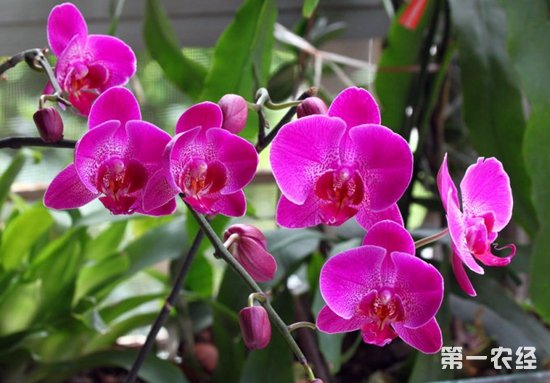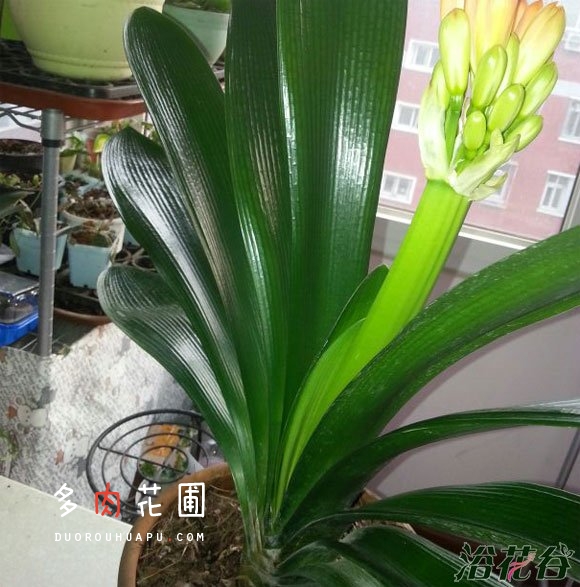How to split the magnolia?
How to split the orchid? when the plant grows to a certain size, it will grow tillers from the mother, some will grow one plant, and some will grow more than one plant, which is a way to reproduce. In order to raise more magnolia and reduce the excessive nutrient consumption of the mother plant, separate plants can be planted separately. The dividing time of Cymbidium can be in both spring and autumn, usually from April to May in spring, when the tiller seedlings grow to 4 or 5 leaves, the pots are changed in combination with the mother plant.
When the gentleman orchid ramet, the basin soil should not be sticky, first tap a few basin walls, so that the soil and basin loose, and then one hand index finger and middle finger clamp the rhizome, palm flat on the soil surface; one hand to support the basin bottom, turn the basin over, pour out the mother plant, pay attention not to break the leaves or damage the flesh root, and then remove the soil near the rhizosphere to reveal the connection between the young plant and the mother plant, break it with your hand or cut it with a knife to separate the young plant.
If the young plants have their own roots, they can be put in a basin with moist culture soil, put in a cool place, water again after 2 days, and can be maintained normally after a week. Ramet seedlings without roots, apply sulfur powder or charcoal powder on the wound to prevent infection and decay. Potted with plain sandy soil is a little deeper than young plants with roots to avoid lodging. After watering, use a plastic cover or put it in a humid environment, do not expose yourself to the sun. The potted soil should be moist and should not accumulate water. Room temperature requires 20-25 ℃. New roots can grow in about a month, and then planted with cultured soil.
After the young plant is divided, the mother plant is smeared with sulfur powder or charcoal powder to clean up the rotten roots and broken roots, and planted in the original basin or large one pot according to the growth situation.
It can also be transplanted from September to October in autumn, because this is the time when the orchid is in the period of germination, and it is beneficial to the growth and development of the mother plant or offspring.
Cymbidium how to ramet in the propagation method is more commonly used, there are flower friends do not know how to plant, for fear of improper treatment, in fact, Cymbidium ramet is not as complex as you think, master a good time on the success of half, the best time is the average temperature between 15 ℃ ~ 25 ℃, south of the Yangtze River can be carried out before and after Ching Ming Festival. At this time, Cymbidium has just blossomed and entered a vigorous vegetative growth period. while turning over the pot and changing the soil, young plants can be cut and propagated. In the second half of the year, the ramet can be carried out between White Dew and the Autumn Equinox, so that the new plant after being cut off from the mother has a longer growth period. Whether it is a ramet in spring or autumn can be determined according to the size of the seed. After the daughter plant is too small, the growth is slow, and the daughter plant is too large, which affects the growth of the mother plant. In general, when the daughter plant grows 3 to 5 leaves, it is very beneficial to the growth of the daughter plant and the mother plant. In other words, what should be reversed in the first half of the year cannot be put off until the second half of the year, still less can it be put off until the next year. The specific method of gentleman orchid ramet 1, blade: can choose medical scalpel, or decoration with thin slice knife, it is best to use potassium permanganate solution disinfection and sterilization before use. 2. Prepare flowerpots and potted soil. The flowerpot should be well drained, loose and breathable and free of germs. The basin soil can be prepared for two kinds of substrates. One is pure sand matrix. Sift out the powder in the ordinary river sand with a fine sieve, then rinse it with clean water, then rinse the poison with boiling water, and set aside after drying. River sand is an excellent substrate for rooting of ramets of Cymbidium, which is very beneficial to the planting and survival of seedlings. Second, rotten leaf soil, this acidic soil contains a variety of nutrients, which is suitable for cultivating seedlings with roots cut off from the mother. Using this medium to cultivate split seedlings, generally slow seedlings a few days later, the seedlings can restore vitality, and quickly use their own roots to absorb water and nutrients from the substrate for healthy growth. 3. After cutting, the prepared vitamin B12 solution should be used to smear the wounds of the mother and daughter plants, and the wounds should be dried and disinfected with charcoal powder or sulfur powder. After this work is done, seedling cultivation can be carried out. 4. In ramet operation, the mode of bud selection should be determined according to the growth position of the daughter plant. Whether it is necessary to turn the basin depends on the exposure of the daughter plant, if the exposure condition of the daughter plant is good, and the mother plant is less than two years after turning the basin, it is not necessary to turn the basin to remove buds. As long as the culture soil is planed, the position of the offspring on the mother can be seen, and the buds can be cut and propagated; if the offspring grow at the bottom of the rhizosphere of the mother, the basin must be turned. The whole plant can be gently lifted, the attached old soil can be shaken off, the daughter plant can be exposed, and the sub-plant can be taken by the method of breaking or cutting. During the operation, the faster the knife, the better, and the smaller the wound, the better, which is beneficial to the wound healing and growth of the seedlings. 5. The depth of pot cultivation should be based on burying the rhizome of the seed plant and stabilizing the plant. When potting, we should pay attention to the close attachment of the seedling rhizome and sand grains. Straighten up the seedlings that are tilted by watering. For rootless ramet seedlings, if they are unstable during cultivation, bamboo sticks can be inserted into the substrate, and then the ramet seedlings can be tied to the bamboo sticks to make them fixed. Generally, after 30 to 40 days, new roots can grow smoothly. How to separate plants of Cymbidium
Gentleman orchid, nicknamed Dazhong orchid, is a kind of flower that blossoms in winter and spring, avoiding high temperature. Cymbidium can be propagated by sowing or ramet method. The sowing seedlings of Cymbidium can grow 16 leaves and begin to blossom and bear fruit in the fourth year, and ramet reproduction can be carried out in the fifth year. Today, the editor will introduce to you the operation of the next ramet.
When the seedlings germinate, the young leaves come together and drill out of the soil in the shape of a sword. at this time, the root seedlings do not grow from their own roots, and the young leaves begin to take root, so do not rush to split up and let it grow on the mother plant for another period of time.
Before dividing the plant, remove the mother plant from the flowerpot, remove the surrounding soil, let the root system exposed, find out the part where the root seedling is connected with the mother plant, and cut them with a knife so as not to hurt the young roots on the root seedling.
Then the mother plant was planted with the new culture soil, and the root seedlings were planted in a small pot.
- Prev

Why doesn't Phalaenopsis bloom?
Why does Phalaenopsis not bloom, Phalaenopsis cultivation requires special management, but it does not mean that it cannot grow in the room, and a large part of orchids can grow well in the general room. To cultivate Phalaenopsis successfully, light, temperature and humidity must be strictly controlled.
- Next

Clivia summer conservation
Clivia summer maintenance, clivia hi cool, humid, semi-shady environment, suitable temperature for growth is 15~25℃, if the temperature is higher than 26~28℃, it will be dormant or semi-dormant state. If the temperature is higher, it will cause illness and death. Therefore, the summer maintenance of Clivia is very important, such as taking the following measures
Related
- Fuxing push coffee new agricultural production and marketing class: lack of small-scale processing plants
- Jujube rice field leisure farm deep ploughing Yilan for five years to create a space for organic food and play
- Nongyu Farm-A trial of organic papaya for brave women with advanced technology
- Four points for attention in the prevention and control of diseases and insect pests of edible fungi
- How to add nutrient solution to Edible Fungi
- Is there any good way to control edible fungus mites?
- Open Inoculation Technology of Edible Fungi
- Is there any clever way to use fertilizer for edible fungus in winter?
- What agents are used to kill the pathogens of edible fungi in the mushroom shed?
- Rapid drying of Edible Fungi

